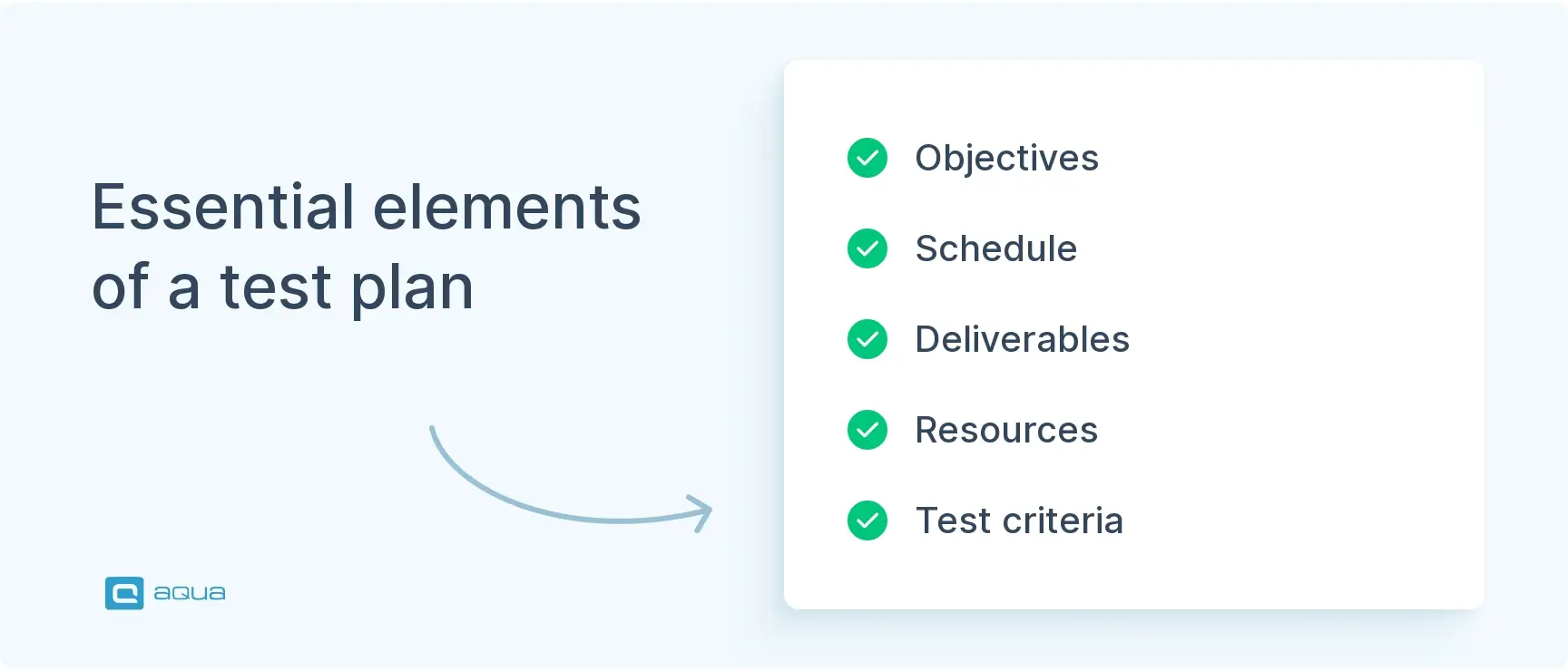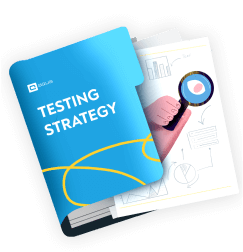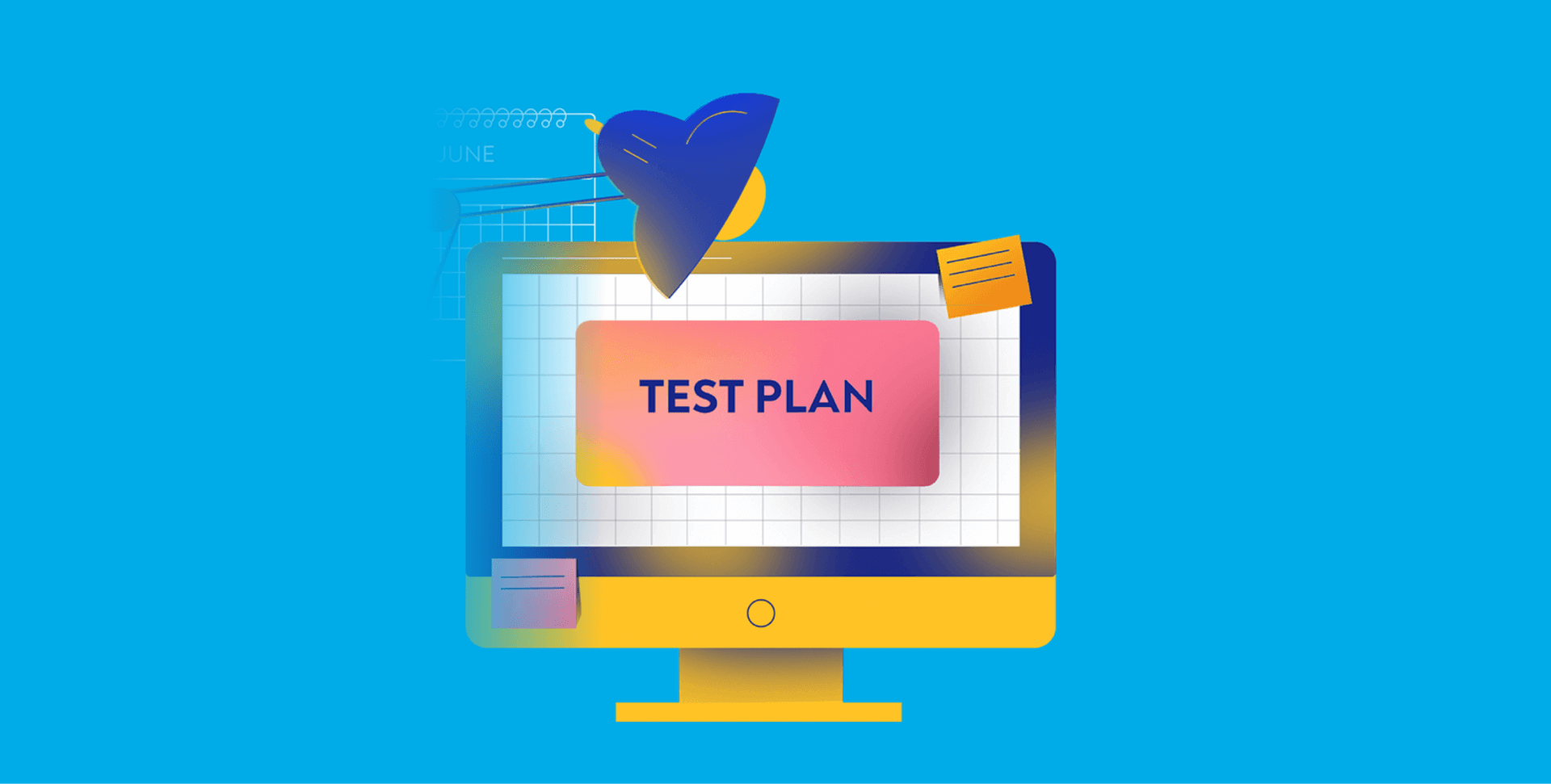What is a software test plan?

A test plan describes how your QA team will tackle testing a particular piece of the software product. To create a test plan, you need to include test objectives, schedule, deliverables, and resources required to achieve them. A quality test plan is well worth the time investment, as a careful approach yields good bug detection and mitigates QA-related time & financial risks.
The beauty of test plans lies in their practically company-wide reach. Few test planning components are particularly technical. The document is mostly accessible to all the stakeholders, painting a picture of quality assurance that resonates with everyone on the project. Testers generally tend to spend less time around their non-tech colleagues than developers, so providing a glimpse into QA work is on the list of benefits as well.

Why is the test plan important?
Now that you know what a software test plan is, let’s dive into why it matters. A well-crafted test plan might sound like just a formality, but it is not. It’s your roadmap to delivering reliable, high-quality software. Here’s why you can’t afford to skip it:
- Clear Direction: It outlines exactly what needs testing, who’s responsible, and how tests will be run. No guesswork, no confusion.
- Risk Management: You will have a higher chance of spotting potential issues early and reducing costly last-minute surprises.
- Resource Efficiency: It helps allocate your team’s time and tools wisely. This keeps the project on track.
- Measurable Results: You’ll know when testing is truly done, based on clear criteria, not gut feeling.
Your test environment can make or break your entire testing strategy. Skip the manual setup headaches and throw in some Infrastructure-as-Code tools like Terraform or use Docker containers to spin up environments that actually match production.
Your biggest wins come from catching those sneaky environment-specific bugs early, not just functional issues.
Start simple and containerised one service this week and watch how much smoother your testing becomes. This approach ensures no critical feature is overlooked, as every test runs consistently within the same test environment setup.
Who Is Responsible for a Test Plan?
So, who takes charge of the test plan? In small teams, test plan management is usually the QA lead or test manager’s responsibility. As you already know, these guys should usually manage everything from defining test cases to tracking progress. In an Agile test environment, the situation is a bit different. Here, the entire team —QA specialists, developers, and product managers work together to align testing with development goals.
There is another scenario where you outsource the testing services. In that case, an external QA team creates the plan but stays in close contact with the in-house team to cover all requirements. For startups or early-stage projects, sometimes developers go an extra mile and handle the test plan themselves until the team expands. No matter the setup, two factors will define the success of the test plan: clear roles and active collaboration.
Test plan and test strategy: are they the same?
While some use the terms interchangeably, this screams conscious or unintended disregard for nuance. Test planning covers a rather narrow scope — they help to ensure that certain parts of the software are up to the standards. As the name suggests, test planning concerns the deliverables and getting there. The test strategy provides the big picture of why your QA specialists do all this.
To better illustrate the difference from test planning, here is what a test strategy could include:
- The technology stack used in the project and how it affects QA
- Project-wide technical risks
- Levels of testing (unless you go full Agile, of course)
- Types of Testing process
- General testing schedule aligning with product development timeline
Test Management Systems (TMS) are pivotal in orchestrating these vital aspects of software testing when considering testing plans and strategies. While test plans focus on specific software components and standards, TMS is a central hub for organising, structuring, and optimising the entire software testing process. It ensures seamless coordination among team members, facilitating efficient communication, resource allocation, and timeline management. A TMS enhances testing through features like test case creation, version control, and comprehensive testing progress tracking, ensuring a systematic approach that boosts software quality and reliability.
Here comes aqua cloud – your ultimate solution for streamlined test planning. By merging essential features beyond traditional tools, aqua revolutionises your QA process. Here is how you are going to do it with aqua:
- Achieve 200% automation by eliminating routine in test case generation
- Create a test plan and execution that is 100% traceable
- Go from fragmented testing to transparent & manageable process
- Get unparalleled customisation and adjust your system to follow your workflow
Say goodbye to multiple tools and hello to swift communication and transparency among teams. With AI integration, aqua auto-generates test cases aligned with your requirements. Experience a new era in testing efficiency and strategy.
Supercharge your QA and save 12.8 hours per tester weekly with aqua
What are the test plan requirements?
Like I mentioned, both the necessity for test plans and the plans themselves can be pretty fluid. Still, there are a few criteria that are wise to apply if you do create a test plan document.
- Conciseness. Avoid long sentences if possible. Introductory phrases should be omitted when possible. A test plan (unlike this article) is not a piece of prose: it’s a daily manual where fluff gets old pretty fast
- Structure. When you prepare a test plan, take the time to organise the content in a neat manner. A good table of contents goes a long way, especially for frequent users that are not always in the context (e.g. programming staff)
- Readability. As mentioned earlier, your test plan should bring value to all stakeholders. Avoid the QA-specific jargon if you can. When you are the one to write test plan, get some feedback from non-tech colleagues to see if they stumble where they shouldn’t
- Adaptability. Things can go wrong, and not necessarily on the QA side of things. A setback on the product, design, or development teams will mean a setback for you. Account for such risks to keep the plan relevant
- Accuracy. Not everyone will be consulting the plan on a daily basis, especially if their job doesn’t require that. An incorrect statement may give some team members wrong ideas that stick with them for months
A test plan is written based upon what you want to measure, and ensure that the measure is tested. From there walk back into what is being done, why it is being done and how it will be used. Then you’ll have an idea of what is required. From a classical perspective, this will be way too much work and will result in typically double the effort it took to code it.
What Are the Objectives of the Test Plan?
Now that you know the test plan requirements, let’s dive into its objectives. What does a solid test plan help you achieve?
- Define Testing Scope: Your test plan outlines exactly what needs testing. It helps you avoid missing critical features and keeps your team focused on the right tasks.
- Set Clear and Specific Goals: With your test plan, you set specific goals for success. You define what works and what doesn’t. This way, everyone knows what to aim for, with no fluff and redundancy.
- Identify Risks and Dependencies: The test plan helps you spot potential problems early. You can address risks like tight deadlines or system integrations before they become issues.
- Assign Roles and Responsibilities: Everyone knows what they’re responsible for. The test plan keeps your team organised and ensures nothing slips through the cracks.
- Track Progress and Metrics: Your test plan lets you measure progress. It gives you the metrics needed to track defects, test coverage, and more, so you can make adjustments on the fly.
Each objective makes your testing process smoother and ensures you stay on track toward a quality product.
A test plan is written based upon what you want to measure, and ensure that the measure is tested. From there walk back into what is being done, why it is being done and how it will be used. Then you'll have an idea of what is required. From a classical perspective, this will be way too much work and will result in typically double the effort it took to code it.
Risk Management and Metrics in Test Planning
Spotting and handling risks throughout your testing process makes the difference between smooth releases and crisis-mode deployments. Smart test plans now bake in risk assessment from the start; you’ll want to list potential blockers, gauge how likely they are, and sketch out your backup plans.
Focus your testing energy on the riskier areas first. It’s way more effective than spreading effort evenly across everything. On the measurement side, keep tabs on metrics like defect density, test coverage percentage, and how efficiently you’re catching bugs. Teams that track these consistently report nearly 40% fewer last-minute surprises. Create a simple risk matrix this week – just plot likelihood versus impact for your top 5 testing concerns. These insights help you pivot quickly, show stakeholders real progress, and build confidence around release decisions.
Types of test plans in software testing
Test plans in software testing are like blueprints to guarantee the quality of a software product. They’re akin to guiding manuals, each with a specific purpose. Below are the types of test plans in testing:
- Functional Test Plan: Defines how to verify the software’s functionality within a well-configured test environment. It outlines specific tests and procedures to ensure every feature operates as intended.
- Integration Test Plan: Details how different modules interact in the test environment, ensuring smooth functionality and compatibility when combined. It helps identify issues that may arise during integration.
- Performance Test Plan: Focuses on evaluating how the software behaves under various workloads within the test environment, ensuring it meets predetermined performance benchmarks.
- Security Test Plan: Acts as a security audit by identifying vulnerabilities and ensuring the software’s resilience against cyber threats.
- Usability Test Plan: Assesses user experience through task analysis and user feedback, ensuring the software is intuitive and user-friendly.
- Regression Test Plan: Ensures that modifications or fixes don’t disrupt existing functionality, maintaining stability after updates.
Each plan is pivotal in QA, contributing to a robust, dependable software product. However, knowing when to create each test plan is not enough. You should also follow some documentation guidelines, which you’ll learn in the following paragraphs.
Test plan documentation standards
As you already know, before developing and testing a new product, the team must write a test planning detailing how they’ll check for any issues. However, this process should adhere to specific documentation standards.
But what are these standards? Well, test plan documentation standards are like the rulebook that ensures everyone speaks the same language in software testing. Here’s a rundown:
- Clarity: Focusing on clarity should be your priority when documenting a test plan. Make sure your plan is crystal clear, outlining what needs to be tested, how it will be tested, and who will do it. It’s like drawing a roadmap for your testing journey.
- Structured Approach: Think of your documentation like building blocks. Organise it logically, with sections dedicated to test objectives, scope, resources, timelines, test cases, and risks. This structure ensures everyone knows where to find what they need.
- Detail-Oriented Style: Be thorough in your documentation. Include specifics about the test environment, testing tools, and methodologies used. It’s like painting a detailed picture of how the testing will unfold.
- Flexibility: While being detailed, allow room for flexibility. Things might change along the way, so your documentation should be adaptable. You should have a blueprint that can be modified without tearing the whole plan apart.
- Clear Responsibilities: Clearly define roles and responsibilities. Who does what, when, and how? It’s crucial for effective teamwork. Think of it as assigning specific tasks during a group project—everyone knows their part.
- Consistency: Stick to a standard format and language. Consistency avoids confusion and ensures everyone understands the document uniformly.
- Goal-oriented approach: Just like ensuring everyone in a conversation speaks the same language, a goal-oriented approach or style in defining all processes within the test plan is also crucial. Each process should not only describe the steps but also articulate the expected outcomes to be achieved.
Remember, test plan documentation is your guiding light throughout the testing process. The clearer, more structured, and more detailed it is, the smoother your testing journey will be!

Get a testing strategy template that allows you to release software twice as fast
How to make test plan: step-by-step guide
Step 0: Analyse the product
This step may not be as relevant if you have been working on the project for a while. On the other hand, test plan development for a new project always means doing the homework. This is even more relevant if the team uses an automated software testing tool. The more you understand what makes the software tick, the more options for automation you will see.
It’s not just fellow QA specialists that should help you understand the product. Ask the product owner about the launch and high priority features, since quality may have been sacrificed in favour of speed. Talk to the project manager to see if they have been facing recurring issues. Ask developers where technical debt risks turning into a point of failure.
Step 1: Define the scope
Test plans are indeed not meant to cover everything about your product. You usually focus on the level of testing (e.g. unit or system testing) and may additionally limit yourself by the types of testing. Functional vs non-functional testing is often quite a distinction in itself. This means you must also carefully consider the test data, test environment, and exit criteria.
Let’s look at banking software testing as an example. Your bank may have introduced a lifestyle section where clients can buy a concert ticket or reserve a table at a restaurant. Your bank also grants loyalty points for all transactions, including lifestyle purchases. If the task is to make sure that loyalty points are correctly granted for these new lifestyle purchases, your test plan concerns integration testing.
The test plan is basically for thinking a bit, about what/how/when etc. you will do during the tests. There can be different test plan levels from developer to UAT. Basically, the test plan should be created and updated in cooperation with the project manager, and project owner.
The test plan basically for thinking a bit, what/how/when etc. you will do during the tests. There can be different test plan levels from developer to UAT. Basically the test plan should be created and updated cooperating with the project manager, project owner.
Step 2: List test criteria
Once you know what to look for, it’s only logical to define what constitutes QA success and failure. Feel free to introduce benchmarks that are relevant to the scope. Some examples include defect rate percentage, test case pass rate, and threshold of severe open defects.
Find more test criteria in our article on when to stop testing.
Step 3: Map the test environment
Now that we know both the scope and the criteria, it’s time to decide how you go about them. Write down all the tools that your testing team uses for software testing. Evaluate whether this test suite is enough for the scope. Research and add new solutions if necessary.
Especially on a new testing project, extra care is needed when preparing QA team for test automation. Run the QA specialists by automated testing ideas that you gathered during the analysis stage. Make sure they are proficient enough with the necessary automation tools to carry out this vision. Resource planning can very well be part of this step even without automation.
Step 4: Create a test plan schedule
The next step is to create a test plan schedule for testing activities to fulfill the scope. Knowing the schedule of product and developer teams is 90% of creating your own schedule. Make sure to account for potential missed deadlines on both your and their ends.
Test automation can really help the testing effort for planning. If individual modules are checked as development happens, your QA specialists spend less time sitting and waiting for the development team to send them the upcoming build. This time can be better spent on exploratory testing and, if necessary, making up for otherwise missed deadlines.
Step 5: Write down deliverables
All that’s left now is to formalise the expected output. The detailed test plan that you may be writing right now is a test deliverable as well. So are the new test cases that your team will make as well as any fruits of the automation labour.
The results are arguably the ultimate test deliverables, as they shape future QA and potentially bug-resolving efforts. You may also come up with a way to present your work to non-QA colleagues at a certain milestone or at the end of the sprint.

Test Plan Example
Now, let’s create the perfect test plan together. It will help you navigate the entire testing process, from start to finish, by clearly defining what needs to be tested and how to do it.
Here’s a simple yet comprehensive test plan example that every QA team should follow:
- Introduction
- Purpose of Testing: Clearly define what you’re testing and why. This helps align the team’s objectives.
- Scope: What features, modules, or functionalities will be tested? Be specific.
- Test Objectives
- Define what you hope to achieve from testing. Is it finding defects, ensuring performance, or verifying compliance with requirements?
- Test Environment
- Define your test environment in detail including the hardware, software, network, and database configurations. This ensures your team tests under the same conditions as your end users.
- Resources and Roles
- Who is responsible for what? Assign tasks to ensure accountability, and list the tools and resources required for testing.
- Testing Strategy
- Define how you’ll approach the testing process—manual, automated, or a combination of both. Outline the methods and types of tests (unit, integration, system, etc.).
- Schedule and Milestones
- Set timelines for each phase of the testing process, from test creation to final reporting.
- Exit Criteria
- Define what will determine if testing is complete. What metrics or results are necessary to conclude testing?
Let’s put it in a table template so you can use it as you go:
| Section | Description |
|---|---|
| Introduction | – Purpose of testing: Define goals – Scope: Features/modules to be tested |
| Test Objectives | – Achieve specific goals (defect finding, performance checks, etc.) |
| Test Environment | – Hardware, software, network, and database details – Replicate real-world conditions |
| Resources and Roles | – Assign team members and responsibilities – List tools and resources needed |
| Testing Strategy | – Define testing methods (manual, automated, etc.) – Specify types of tests (unit, integration, system) |
| Schedule and Milestones | – Set clear timelines for each testing phase – Define key milestones for tracking progress |
| Exit Criteria | – Determine when testing is complete – Set metrics or results that indicate success |
Each section is designed to make your testing process more organised and aligned with your project goals. Feel free to copy and use it for your own testing efforts. Good luck!
Keeping Your Test Plan Agile and Up-to-Date
Your test plan isn’t a ‘set it and forget it’ document; it needs to breathe with your project. When features shift, risks pop up, or team members change, update your plan to match what’s actually happening. During sprint retrospectives, spend 10 minutes reviewing whether your test plan still reflects reality.
Many teams skip this step and end up testing outdated requirements or missing new features entirely. In fast-moving projects, teams that regularly update their test plans catch nearly 40% more critical issues compared to those using static documents. Use your Test Management System’s version history to track changes – this way, everyone knows they’re working from the current playbook, not last month’s wishful thinking. Your future self will thank you when priorities inevitably shift again.
Conclusion
A solid test plan is a useful tool with advantages that go beyond QA effort. It formalises your testing approach, opens it up to other stakeholders, and helps navigate potential challenges within and outside the QA team. Great preparation does yield great results, and software quality assurance is no exception.
Your test plan isn’t set in stone. Tweak it whenever the scope shifts or team roles change. Here’s what’s working now: AI tools can auto-generate test cases and even fix broken automation on their own. Smart teams prioritise tests based on recent code changes, which nearly halves testing time. Start small—pick one AI-powered testing tool and run it on your most critical user flow first. aqua AI copilot creates entire tests or complete drafts in no time. The more things you can delegate to AI, the better and/or faster you can cover all requirements.
Use AI to fit more deliverables into your test plan


















